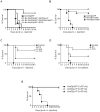"VSports app下载" Yersinia pestis endowed with increased cytotoxicity is avirulent in a bubonic plague model and induces rapid protection against pneumonic plague
- PMID: 19529770
- PMCID: V体育平台登录 - PMC2691952
- DOI: 10.1371/journal.pone.0005938
Yersinia pestis endowed with increased cytotoxicity is avirulent in a bubonic plague model and induces rapid protection against pneumonic plague
"V体育ios版" Abstract
An important virulence strategy evolved by bacterial pathogens to overcome host defenses is the modulation of host cell death. Previous observations have indicated that Yersinia pestis, the causative agent of plague disease, exhibits restricted capacity to induce cell death in macrophages due to ineffective translocation of the type III secretion effector YopJ, as opposed to the readily translocated YopP, the YopJ homologue of the enteropathogen Yersinia enterocolitica Oratio8. This led us to suggest that reduced cytotoxic potency may allow pathogen propagation within a shielded niche, leading to increased virulence. To test the relationship between cytotoxic potential and virulence, we replaced Y. pestis YopJ with YopP. The YopP-expressing Y. pestis strain exhibited high cytotoxic activity against macrophages in vitro. Following subcutaneous infection, this strain had reduced ability to colonize internal organs, was unable to induce septicemia and exhibited at least a 10(7)-fold reduction in virulence. Yet, upon intravenous or intranasal infection, it was still as virulent as the wild-type strain. The subcutaneous administration of the cytotoxic Y. pestis strain appears to activate a rapid and potent systemic, CTL-independent, immunoprotective response, allowing the organism to overcome simultaneous coinfection with 10,000 LD(50) of virulent Y. pestis. Moreover, three days after subcutaneous administration of this strain, animals were also protected against septicemic or primary pneumonic plague. Our findings indicate that an inverse relationship exists between the cytotoxic potential of Y. pestis and its virulence following subcutaneous infection. This appears to be associated with the ability of the engineered cytotoxic Y. pestis strain to induce very rapid, effective and long-lasting protection against bubonic and pneumonic plague. These observations have novel implications for the development of vaccines/therapies against Y. pestis and shed new light on the virulence strategies of Y. pestis in nature VSports手机版. .
VSports - Conflict of interest statement
Figures





References
-
- Cornelis GR. Yersinia type III secretion: send in the effectors. The journal of Cell Biology. 2002;158:401–408. - "V体育官网" PMC - PubMed
-
- Mota LJ, Cornelis GR. The bacterial injection kit: type III secretion systems. Ann Med. 2005;37:234–249. - PubMed
-
- Viboud GI, Bliska JB. Yersinia outer proteins: role in modulation of host cell signaling responses and pathogenesis. Annu Rev Microbiol. 2005;59:69–89. - PubMed
MeSH terms
- "VSports最新版本" Actions
- V体育2025版 - Actions
- "VSports最新版本" Actions
- "V体育ios版" Actions
- Actions (VSports app下载)
Substances
- Actions (VSports最新版本)
- V体育安卓版 - Actions
- V体育安卓版 - Actions
LinkOut - more resources
Full Text Sources
Medical
Research Materials

